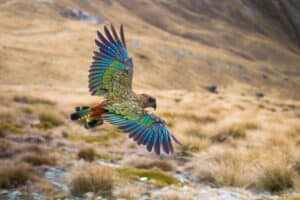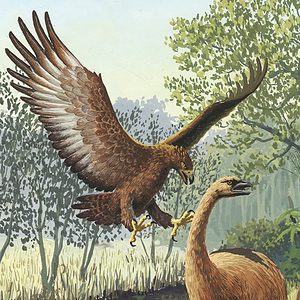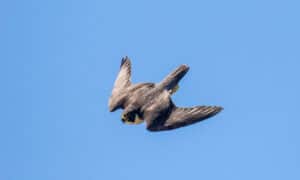There are plenty of fascinating birds that start with S. They range from delicate songbirds to striking birds of prey. However, spotting some of these birds can be difficult if you do not know where to start.
Whether you are a seasoned bird watcher or someone who loves nature, a comprehensive bird’s guide can help. Below are some of the best birds that start with S to look for. Discover why they stand out and develop an appreciation for these remarkable birds!
Interesting Birds That Start with S
1. Sage Grouse
The sage grouse’s scientific name is Centrocercus urophasianus. The bird had an approximate global population of about 16 million at one point. However, their numbers have since dwindled. Today, there are about 200-400 thousand in total.
The best time to spot the sage grouse is when they gather in open ground patches during early spring. This is their mating season, and you can see males strutting to attract females.
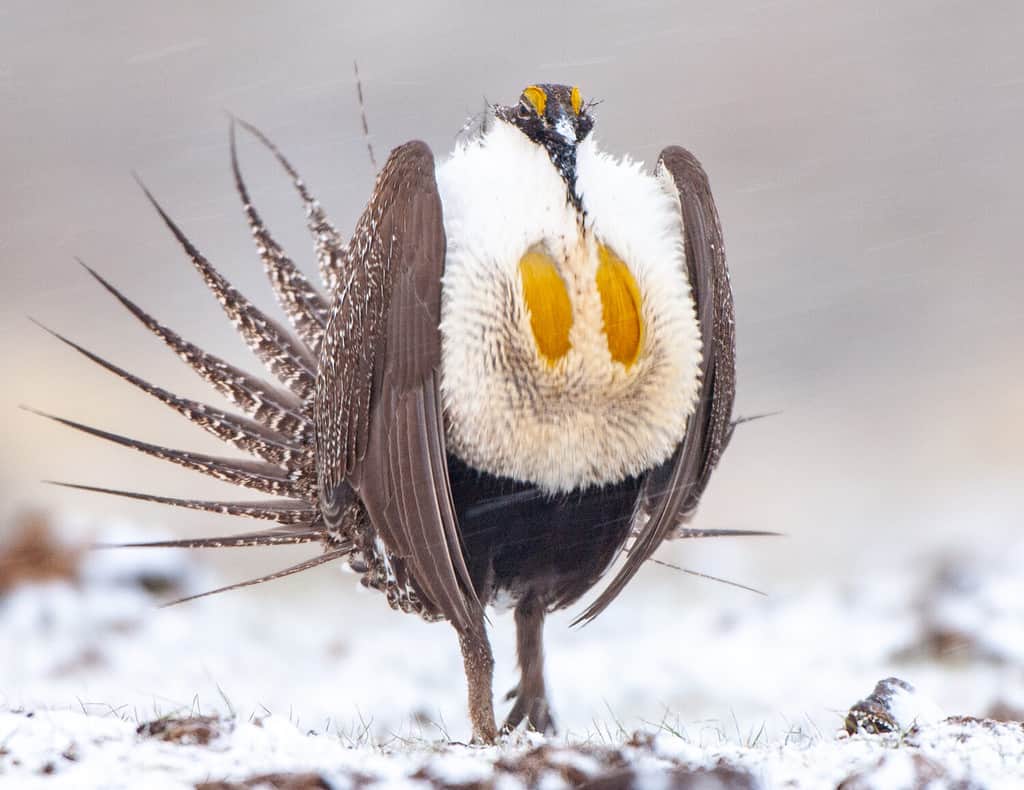
A male sage grouse has a large white ruff and inflated yellow chest sacs.
©Nattapong Assalee/Shutterstock.com
Sage grouse fall under distinct species. The first is the greater sage grouse, often found in the Western United States. It also resides in some areas of Canada on the Southwestern coast.
The second species is the Gunnison sage, which is more prevalent in Utah and Colorado. However, they are only common in a small area.
Overall, the sage grouse is the largest grouse living in temperate America. The adult bird has a distinct appearance with pointed legs and tails. Their feathers appear to point towards their toes.
2. Sage Thrasher
Sage thrashers are found in Western North America. You can identify them by their distinct, melodic singing.
Originally known as the mountain mockingbird, its scientific name is Oreoscoptes montanus, which means mimic of the mountains. These birds imitate other birds they share a habitat with, including the horned lark, western meadowlark, and the brewer’s sparrow.
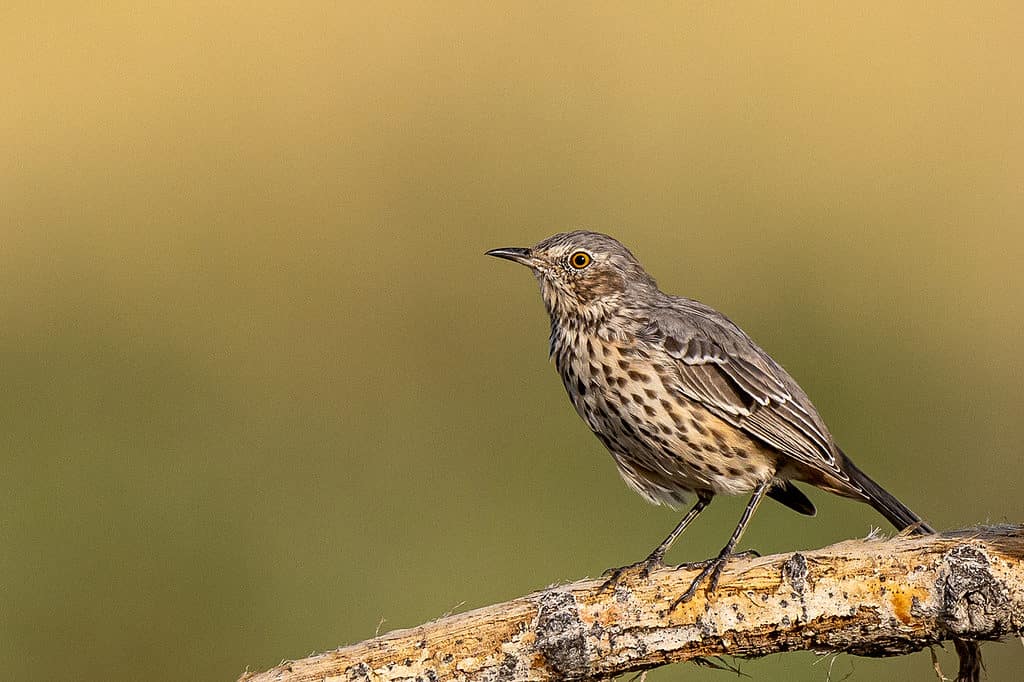
Sage thrasher imitates other birds within its habitat.
©iStock.com/Jeff Edwards
The sage thrasher is a medium-sized passerine bird. They feed mostly on insects and berries.
You will spot them in sagebrush areas, especially where sage lands meet pinyon-Juniper woods. Alternatively, they reside in wide-open flat regions. You can find them in British Columbia and Canada, where they are one of the rarest birds.
3. Sage Sparrow
This bird is scientifically known as Artemisiospiza nevadensis. It currently lives in Mexico and the Western U.S.
The birds’ population is estimated to comprise four million adult breeding birds.
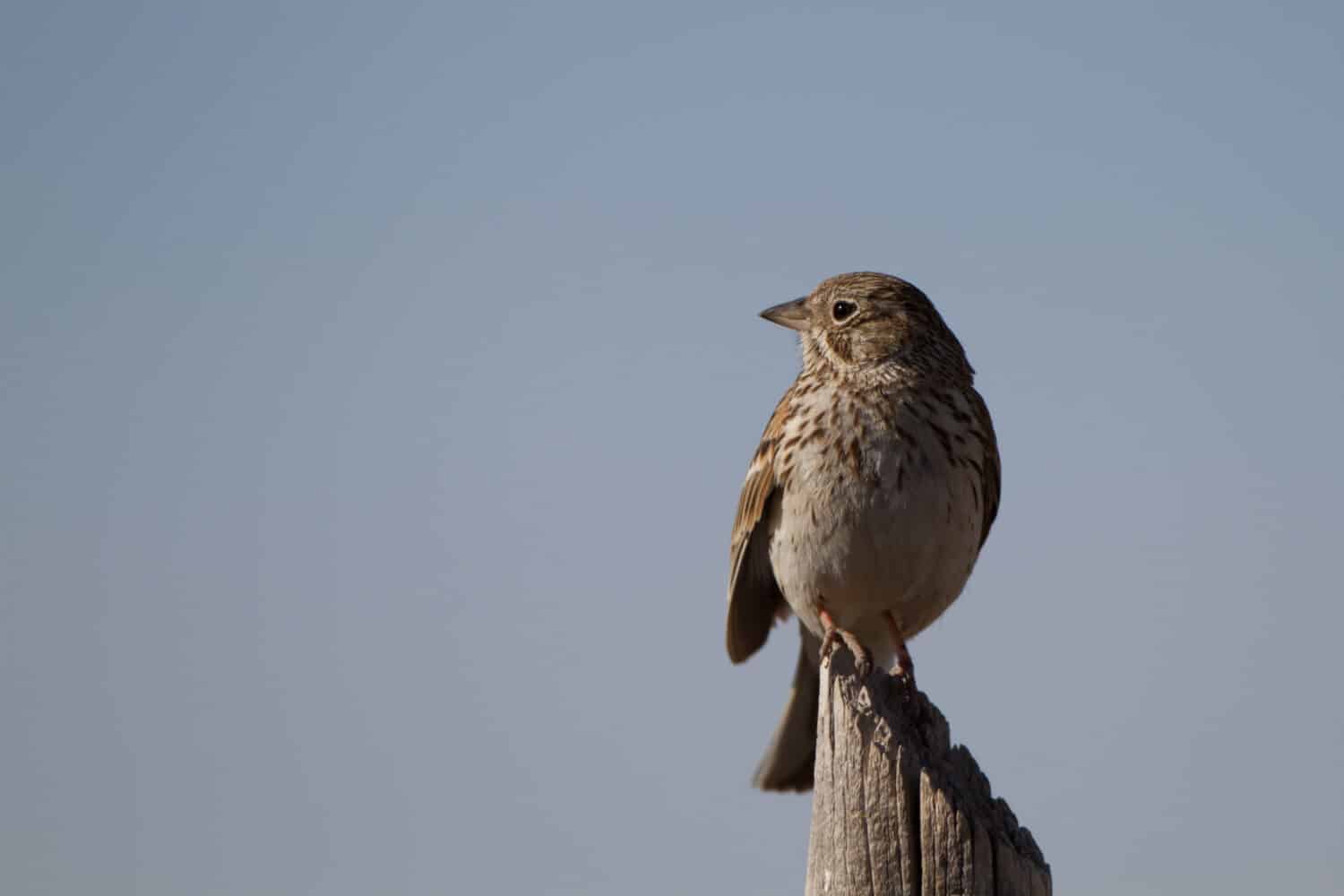
You’ll usually find them hiding in shrubs or on the ground. They breed in saltbush desert and creosote shrubs. Sage sparrows are known for making lively, melodic songs with finely tuned frequencies. These songs carry across wide-open grounds and can attract mates.
4. Scarlet Tanager
This bird goes by the scientific name Piranga olivacea. It is a typical songbird known for its brightly colored appearance. The bird is native to the Eastern North American woodlands.
The male scarlet tanager is difficult to miss during the breeding season, due to his striking red body and black wings. Alternately, the female has olive-yellow plumage.
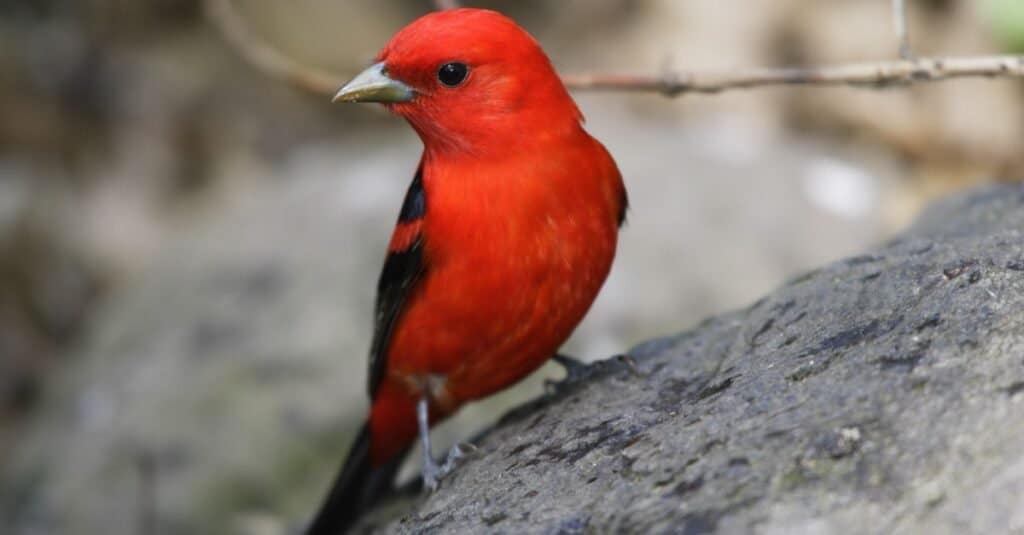
Scarlet tanager has a red body and black wings.
©Stubblefield Photography/Shutterstock.com
The birds mainly feed on insects and fruits. You may see them perching on treetops, searching for their meal. They have a particular song characterized by a mixture of short high-pitched phrases. Usually, they migrate to South America during winter and can travel for 3,000 miles.
As a bird watcher, you must carefully scout for them. Even though their bright colors are conspicuous, they are not the easiest birds to find. This is because they prefer sitting high on tops of trees.
5. Sandhill Crane
The sandhill cranes are scientifically known as Antigone canadensis. The birds stand out because of their long necks and legs, along with their tall height. They also feature broad wings.
These birds feed on invertebrates and grains found along North America’s grasslands. Most hover around marshes and prairies. When migrating, they fly high in the sky in large flocks, making their way toward winter grounds.
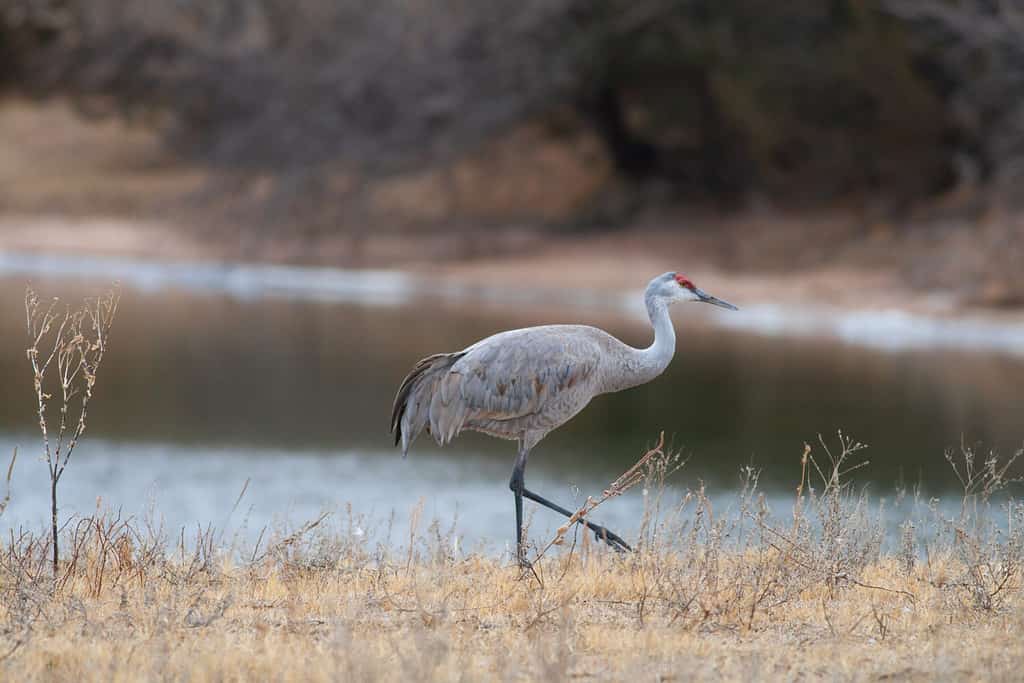
The sandhill cranes stand out because of their long necks and tall height.
©Benjamin Tillotson/Shutterstock.com
They are known to have a few popular stopovers during these migrations. The Platte River in Nebraska is one of them.
If you hear the unique call, you can always tell a sandhill crane is in your vicinity. They produce these songs when their trachea loops twice through the sternum. This often creates a unique, resonating trumpet-like sound.
6. Scissor-Tailed Flycatcher
The bird goes by the scientific name Tyrannus forficatus. It is found in Northern Mexico and the U.S.
The scissor-tailed flycatcher feeds on insects, especially grasshoppers, beetles, and crickets. These birds are mainly found in Missouri, Louisiana, Oklahoma, and Kansas.
They generally breed in shrubs, brush patches, and trees. The males and females continuously search for nesting sites. They determine the best areas by pressing their bodies against the potential site, a way of testing for strength.
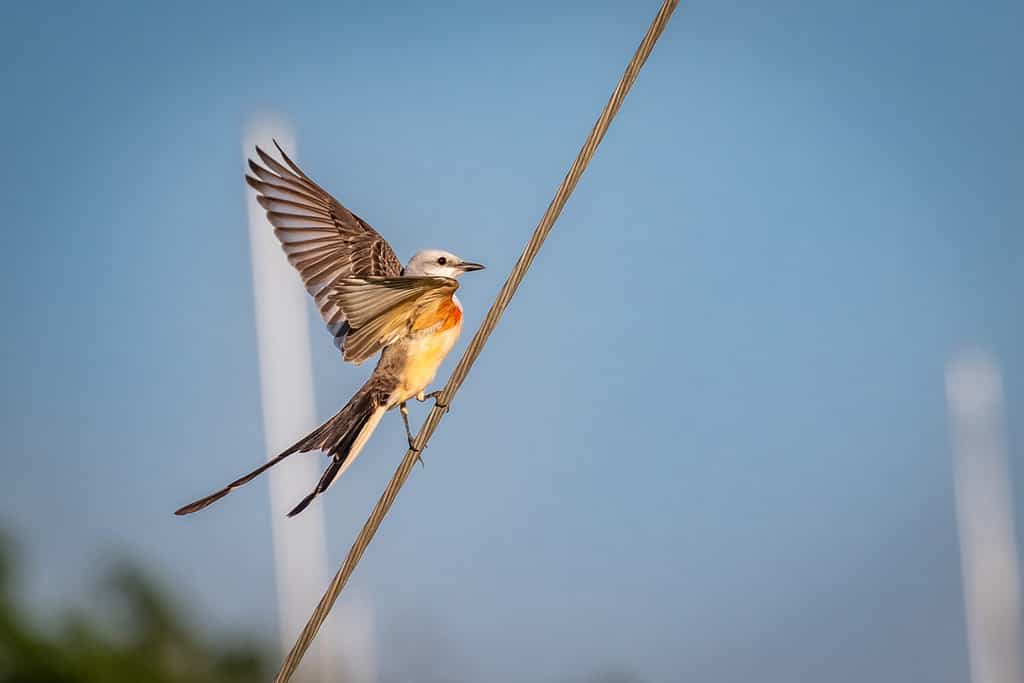
The scissor-tailed flycatcher measures about 14.5 inches long when mature.
©Richard G Smith/Shutterstock.com
The adults are pale gray on the heads and upper body parts. Their underparts are light, while their flanks are salmon pink. They also have gray wings. These birds have long forked tails that are black on top and white on the underside, which makes them stand out.
They are about 14.5 inches long when mature. Flycatchers that are yet to mature have a dull color and also tend to have short tails.
Scissor-tailed flycatchers are medium-sized songbirds. They are commonly known as the Oklahoma bird of paradise.
7. Sharp-Shinned Hawk
The sharp-shinned hawk, or Accipiter striatus, is the smallest hawk in the U.S. They prey on rodents and small birds, puncturing prey using their long talons and toes. They also pluck the feathers before eating.
These hawks are easily found in North America.
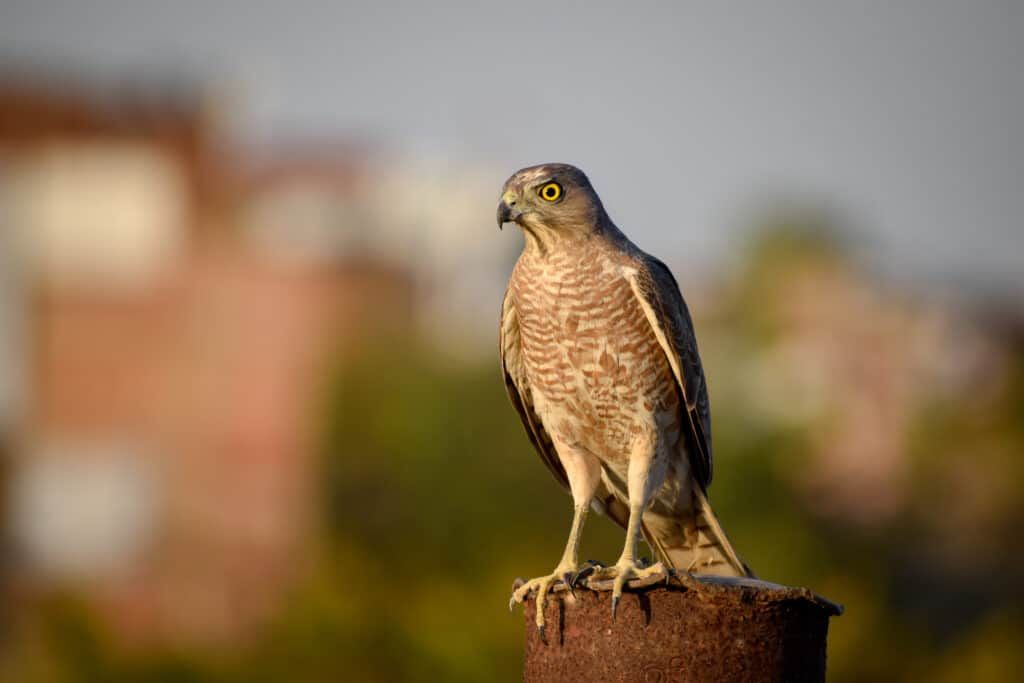
Sharp-shinned hawks are the smallest hawk in the U.S.
©Vizz Effect/Shutterstock.com
Birdwatchers can spot them in open spaces as they glide and flap in a recognizable flight pattern. However, they are not the easiest birds to spot unless it’s migration season.
8. Short-Eared Owl
This bird is scientifically known as Asio flammeus, meaning “color of fire.” These are some of the most common birds in America. They can be found anywhere from Alaska to South America, primarily in the U.S.
They can be seen in winter marshes, rock and gravel quarries, woodlots, fields, and thickets. The birds have a unique appearance, with ear tufts that are only visible when the bird is in a defensive position.
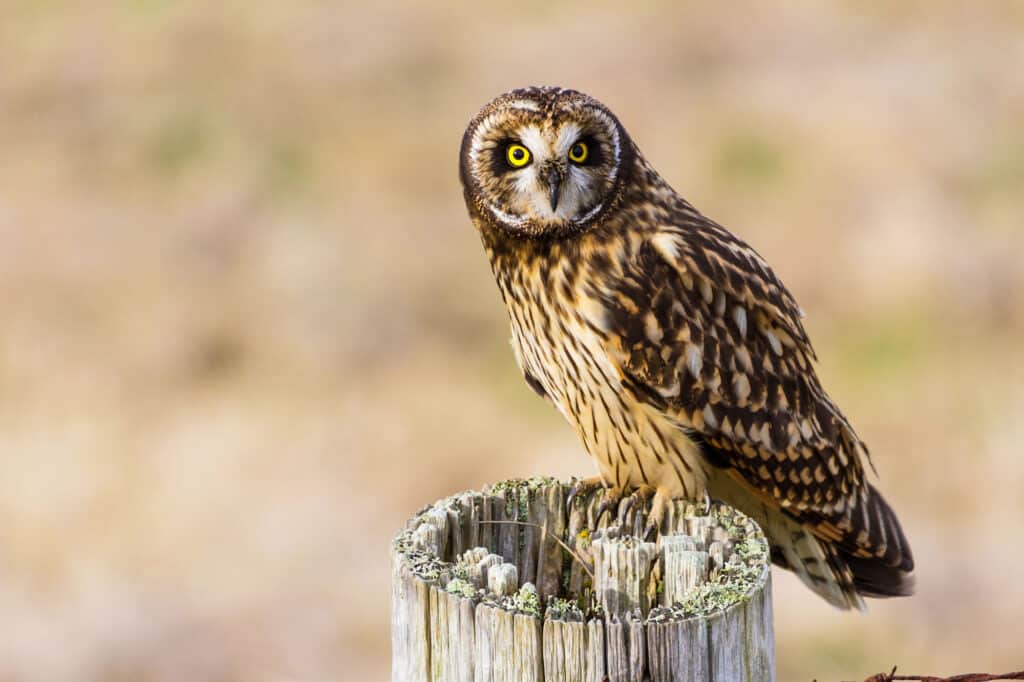
Short-eared owls are prevalent in America.
©iStock.com/Devonyu
Their populations tend to vary from one year to the next and will depend on prey availability. These include rabbits, moles, and weasels. Generally, though, these birds are believed to be declining in numbers. This phenomenon is attributed to their sensitivity to habitat loss. Fragmentation from large open grasslands also affects them.
These birds are easily found in open grasslands and open country. They lose ground when fields are converted into grazing land, farmlands, housing developments, or recreational facilities.
9. Skylark
Skylark is scientifically known as Alauda arvensis. The birds are small and dull colored in appearance. They are grayish-brown and mostly live in North Africa, Asia, and Europe. Their favorite food includes insects and seeds easily found on the ground.
The birds are recognizable, thanks to their bubbly melodic sounds. It’s estimated that a skylark’s song contains 160 to 400 syllables. This makes it one of the most uniquely vocal birds. Males deliver their songs while hovering at about 50 to 100 meters high. Their songs last about two to three minutes and may be longer in the breeding season.
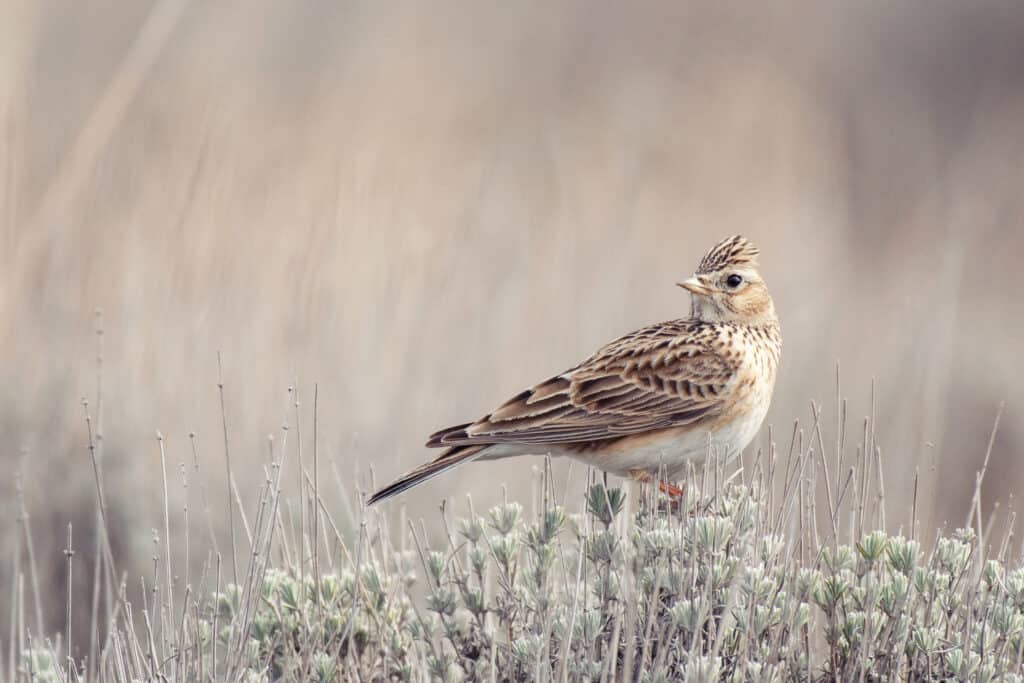
Skylarks make bubbly melodic sounds.
©WildlifeWorld/Shutterstock.com
Skylarks are medium-sized and often measure about 16 to 18 cm long. Males tend to have broader wings compared to their female counterparts. This is part of their evolving adaptation to help them hover more efficiently. Female skylarks tend to prefer males that hover and sing longer, thus demonstrating general fitness.
10. Snowy Egret
The snowy egret is scientifically known as Egretta thula. The bird prefers nesting around marshes, wet fields, and grassy ponds. They eat aquatic animals such as frogs, insects, fish, and worms.
You can easily identify them due to their bright white feathers, long legs, and long toes. Snowy egrets also have bright yellow feet that turn reddish orange during the breeding season. Mates are only accepted if they can perform an elaborate greeting.
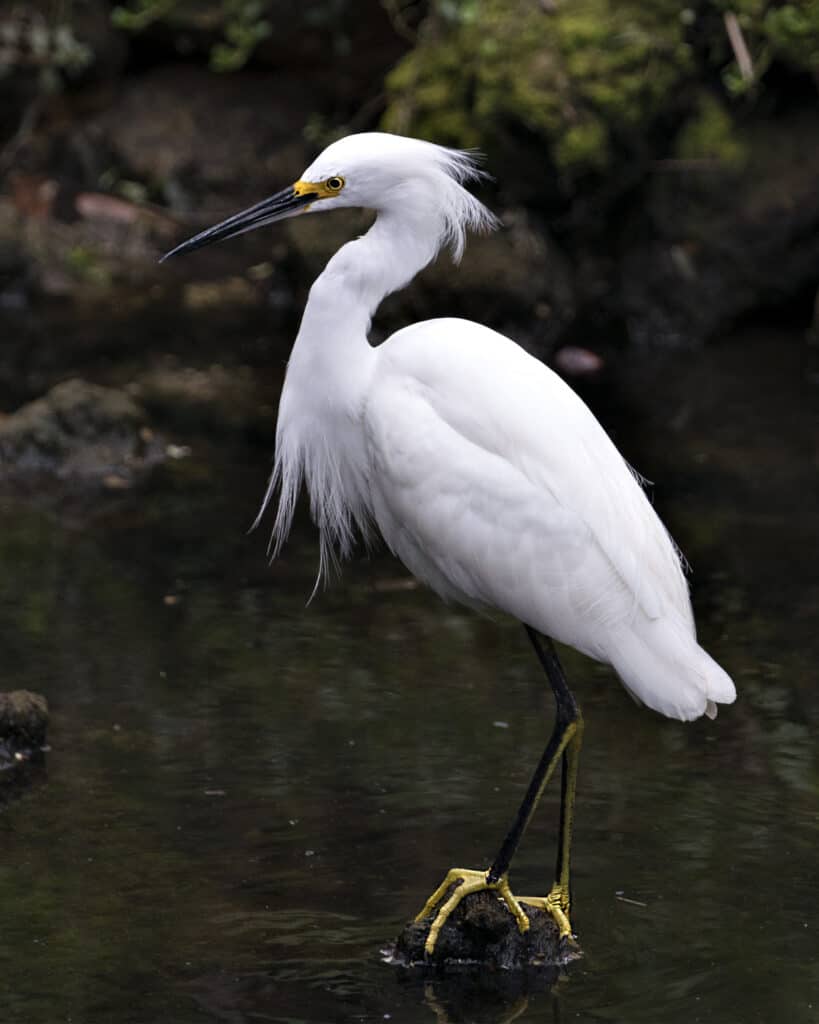
The snowy egrets have long bright-yellow legs.
©iStock.com/Rejean Bedard
Their long yellow legs also serve as excellent bait when fishing for prey. They can attract fish as they stir the water with their feet.
During the breeding season, these birds grow a long but delicate plume on their back. This plume was highly sought after for decorative purposes.
The snowy egret is generally a small white heron, measuring 55 to 66 cm in length. They are widely found in the Bahamas.
11. Snowy Owl
The snowy owl is scientifically identified as the Bubo scandiacus. They have a winter range throughout Canada but have been coming further south into the U.S. each year. The owls migrate far north to the Canadian Arctic and Greenland regions, where they breed annually.
Once the snowy owls identify a perfect site for winter, they will continue using this site every year. Snowy owls tend to roost in obvious places.
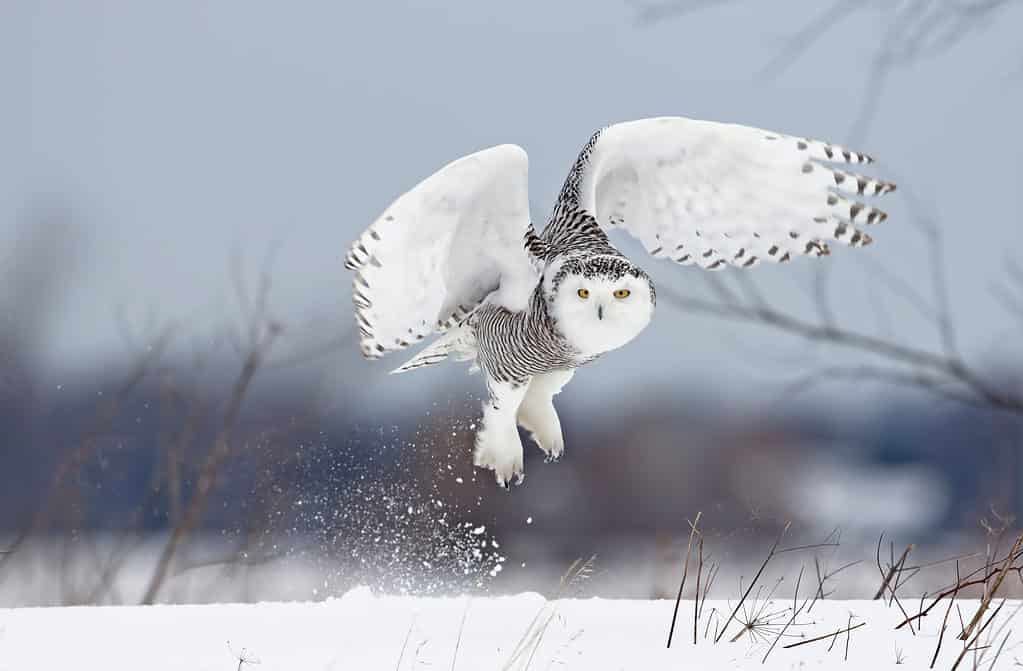
The snowy owls are active during the day.
©Jim Cumming/Shutterstock.com
They are also known to be diurnal, active both during the day and at night. Moreover, they enjoy hunting in wide-open spaces, even though they perch high up.
Snowy owls do not fear leaving their birthplace, which is unique to this species. They scatter in different directions once they mature.
These birds can be 52-71 cm in length. They also weigh between 1.6 and 3 kgs and have a 125-150 cm wingspan. They are common in Europe, Asia, and America.
Due to their predominantly white plumage, these owls tend to blend in with their snowy environment. However, they may have a few black bars and spots on their plumage and feature distinct yellow eyes that are encircled by black rings.
12. Smoky-Brown Woodpecker
Its scientific name is Leuconotopicus fumigates. It is found in Mexico, Northern South America, and Central America. You can always spot this bird in Argentina, Guatemala, Ecuador, Colombia, and Venezuela.
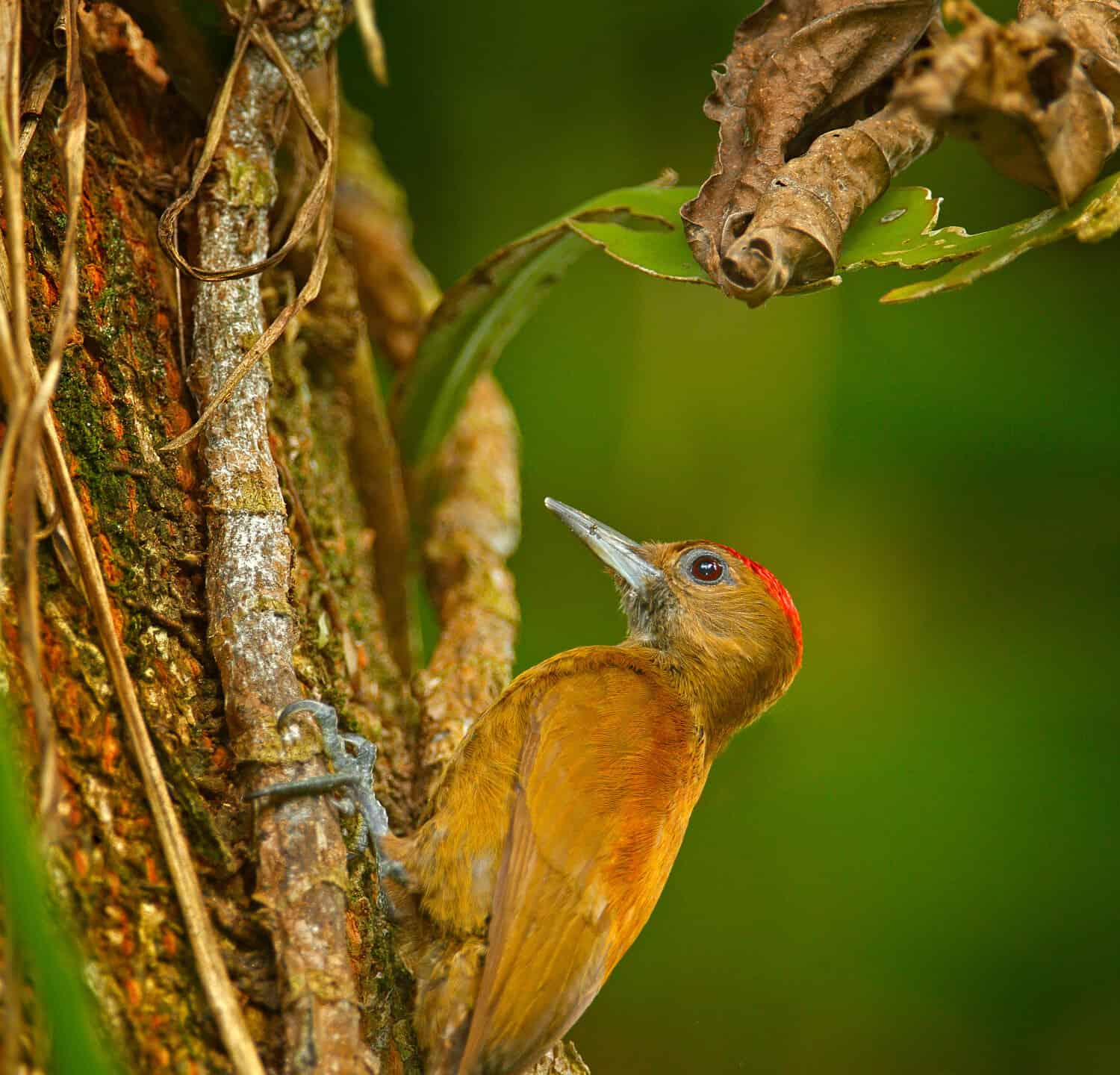
They are a striking smoky brown-red and have a pale face. These woodpeckers thrive in forested woodlands, where they forage for various foods.
13. Swallow-Tailed Kite
This bird goes by the scientific name Elanoides forficatus. It also goes by the name scissor-tailed kite bird. From the Accipitridae family, it is a warm climate raptor with a bright white and black body and a forked and elongated tail. You will likely spot this slender raptor in South America, but they are also common in other areas.
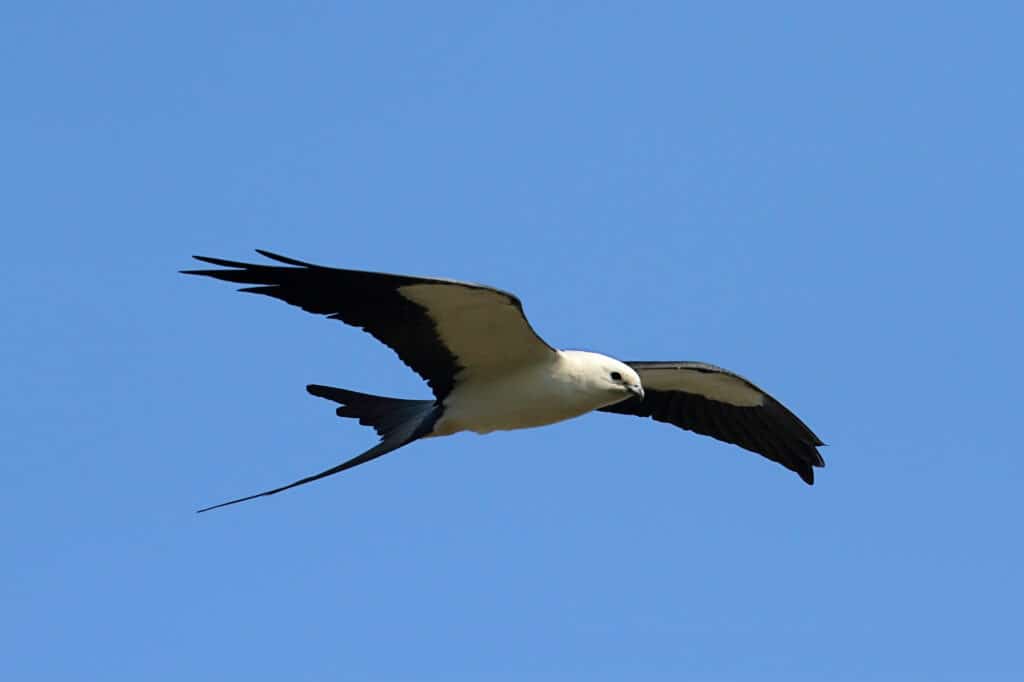
Swallow-tailed kite has a forked and elongated tail.
©iStock.com/SteveByland
They migrate north to breed and can be spotted in Georgia, Florida, South Carolina, and Alabama.
These birds spend most of the day flying above woody wetlands. The high view helps them spot their prey, which includes lizards, small birds, insects, and frogs.
14. Surf Bird
The bird is scientifically known as Calidris virgata, a species in the Scolopacidae family. It is found in Yukon and the Rocky Tundra in Alaska. These birds are found on mountain tundras and rocky coasts. The breeding happens mostly in and around Alaska.

These birds have a bill that resembles a plover. They are gray on the top and orange on the bottom. Surf birds feed on limpets, mussels, and barnacles that nest along rocky ridges.
15. Stellar’s Jay
This bird’s scientific name is Cyanocitta stelleri. While blue jays are the most common of the six types of American jays, stellar’s jays come second. The adult stellar’s jays are half black and half blue and have a large crest.
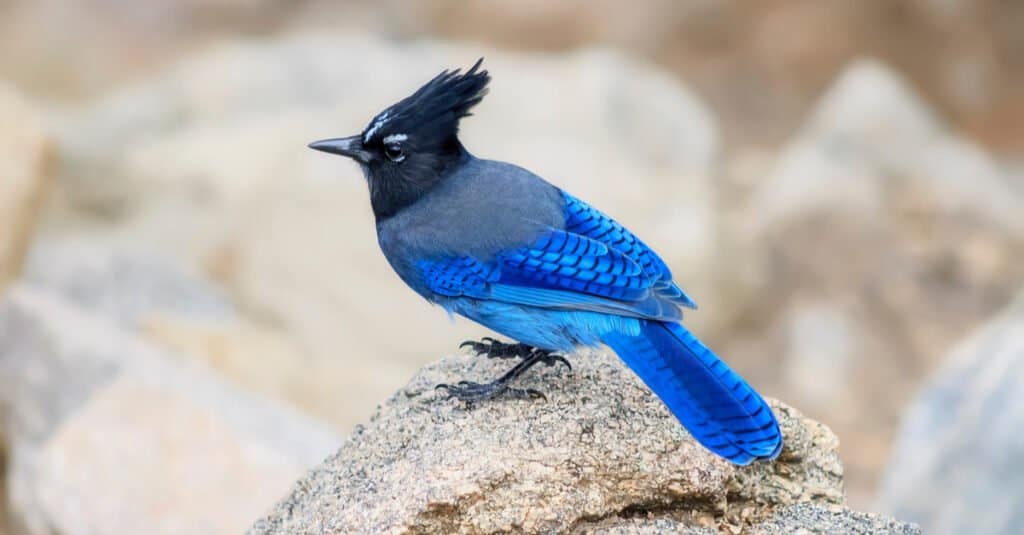
The adult stellar’s jays are half black and half blue and have a large crest.
©dimostudio/Shutterstock.com
The stellar’s jays are most common in Western Colorado. These birds are peanut lovers. However, they are omnivores that also enjoy feeding on insects, small animals, fruits, and seeds.
Size-wise, the birds are 30-34 cm long and weigh 100-140 grams. They tend to be loud with their harsh calls and exceptional mimicry skills. These birds imitate other birds, human sounds, and animal sounds.
These birds are opportunistic nest robbers. They also prey on the bird eggs and nestlings of other species.
The Largest Birds that Start with S
Several large birds start with S, including both flying and non-flying birds. Here are a few of them:
16. Southern Royal Albatross
This is a large bird with a 12-foot wingspan. It is found in the South American waters. However, many of these birds return to their native sub-Antarctic Campbell Island, where they lay eggs.
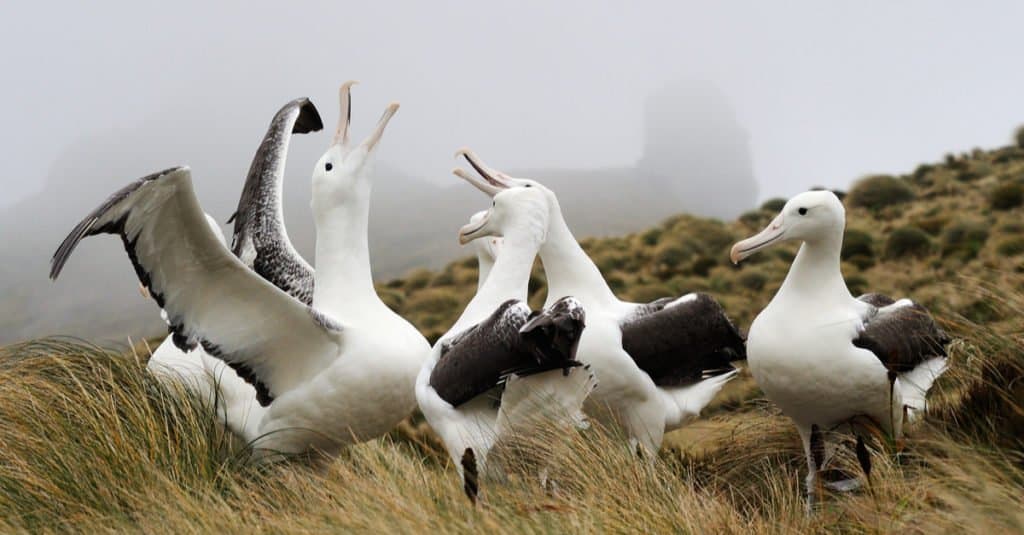
The southern royal
albatross
has a 12-foot wingspan.
©AndreAnita/Shutterstock.com
This migration involves circumnavigation of the globe, during which they feed on fish found on the water’s surface. The birds generally lay an egg or two in November. Eggs hatch in January. Afterward, males and females take time to care for the young ones until the next breeding season.
17. Somali Ostrich
This bird is about 290 pounds. It goes by the scientific name Struthio molybdophanes. It may be smaller than other ostriches, but it is still huge. The bird is native to the Africa and is mostly found in the eastern part of the continent.
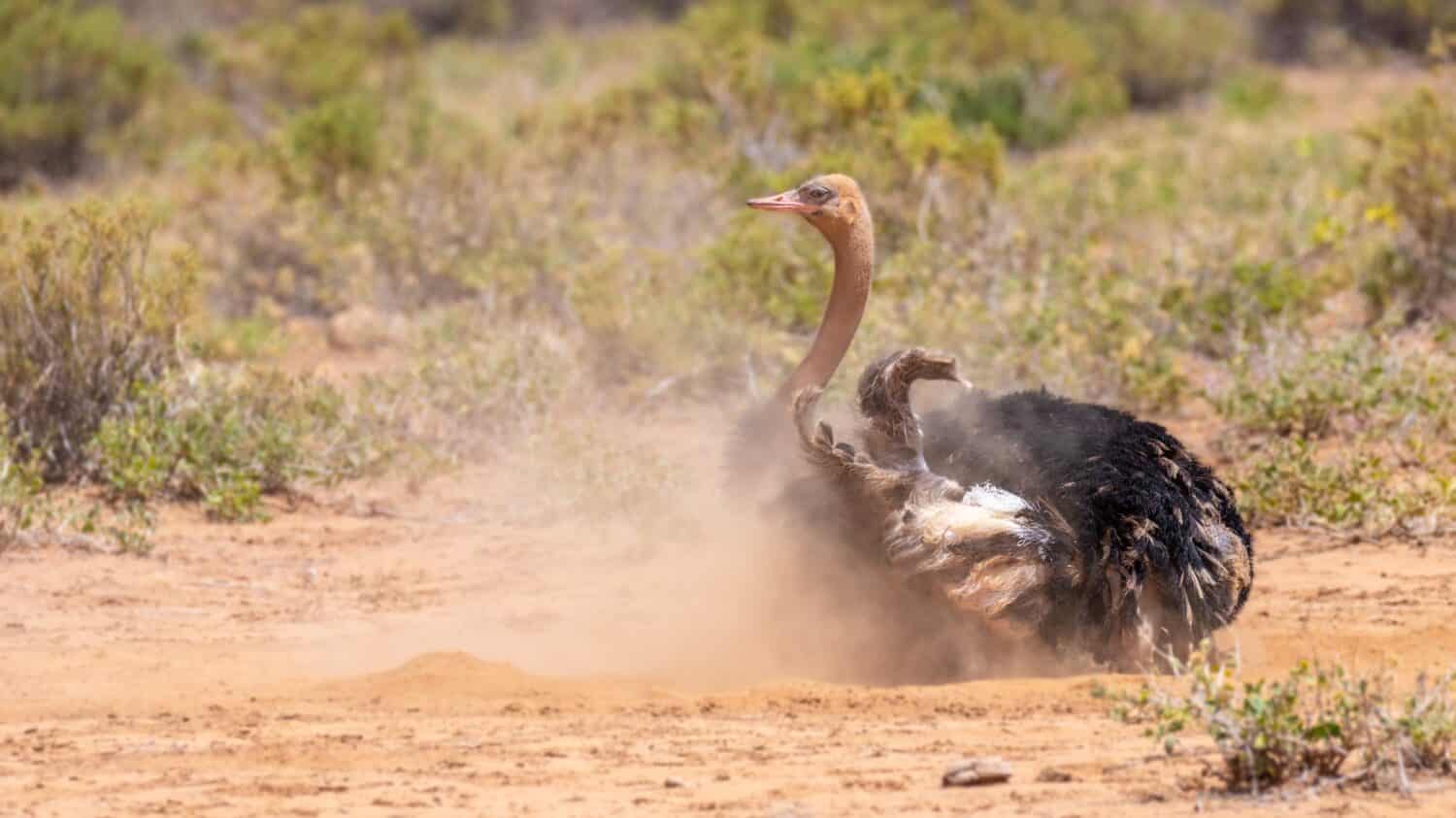
18. Southern Cassowary
The scientific name for this bird is Casuarius casuarius. It is about 190 pounds and has a pre-historic appearance. It is native to the rainforests of Northeastern Australia.
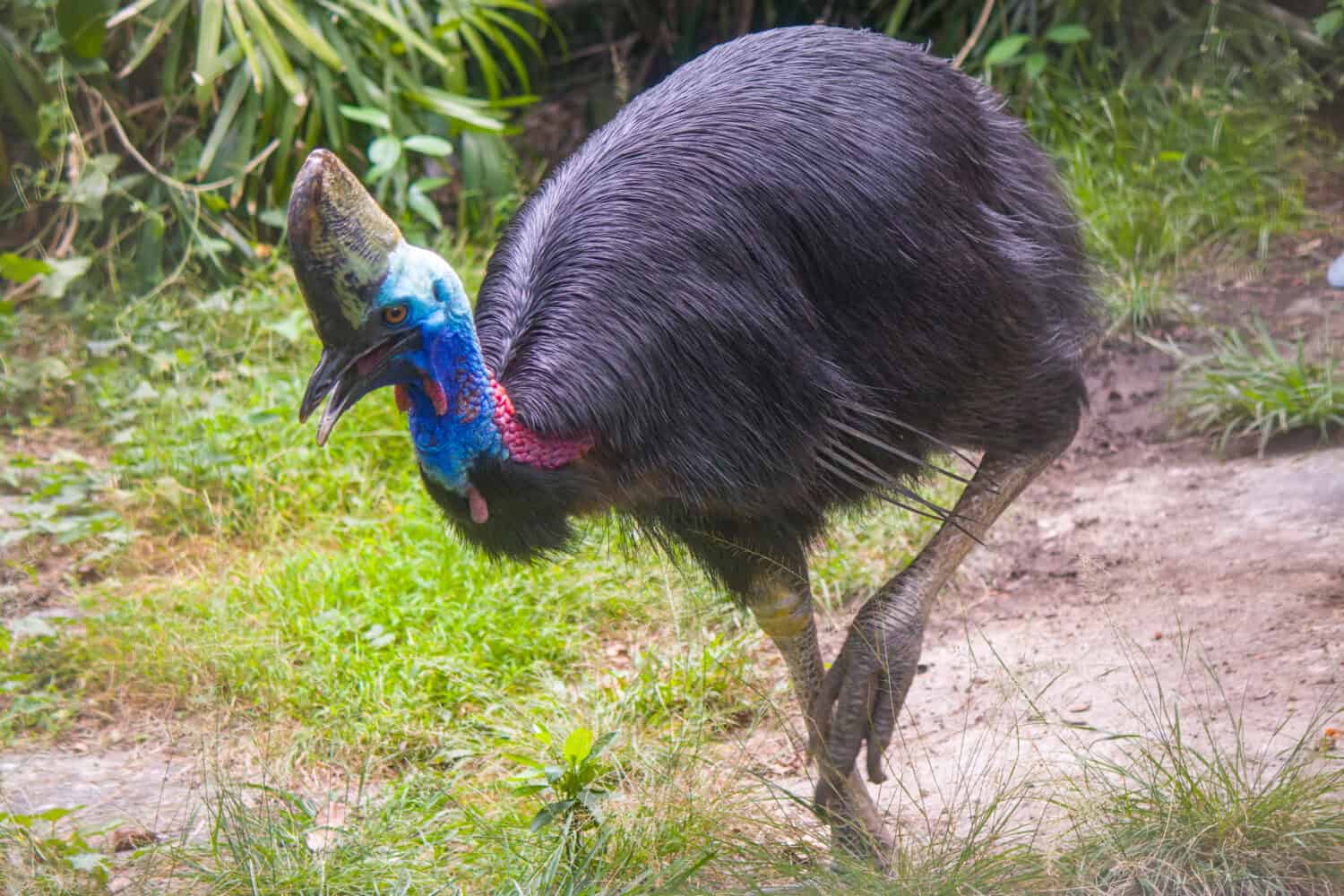
Southern
cassowary
weighs about 190 lb.
©Danny Ye/Shutterstock.com
It can also be found in Indonesia, New Guinea, and Papua New Guinea. There is a high chance that you will hear it before you see it. It has a distinct deep and booming call.
19. Shoebill
This bird scientifically goes by the name Balaenice rex. It is one of the tallest and strangest birds. In fact, it is also known as the whale-headed stork. They are about 5 feet tall and love wading in freshwater swamps, where they hunt small aquatic species and fish.
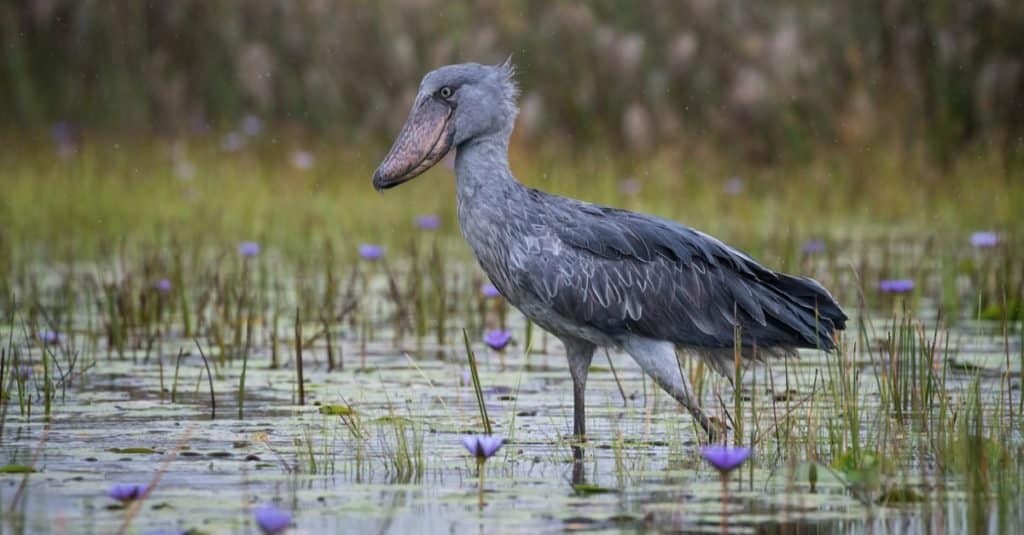
The
shoebill stork
hunts small aquatic species and fish in freshwater swamps.
©Petr Simon/Shutterstock.com
The Fastest Birds that Start with S
Birds have varying speeds commonly measured in two categories: diving and ordinary flight. Below are a few birds that start with S known to be among the fastest birds alive.
20. Saker Falcon
These birds are found in the open grasslands of Africa and Eurasia, where they feed on smaller birds and rodents, like squirrels. They swoop down on their prey at a dive speed of 200 mph, quickly paralyzing the prey after striking. Due to their preferred prey, they are likely to hunt on desert edges and grasslands close to cliffs and trees.
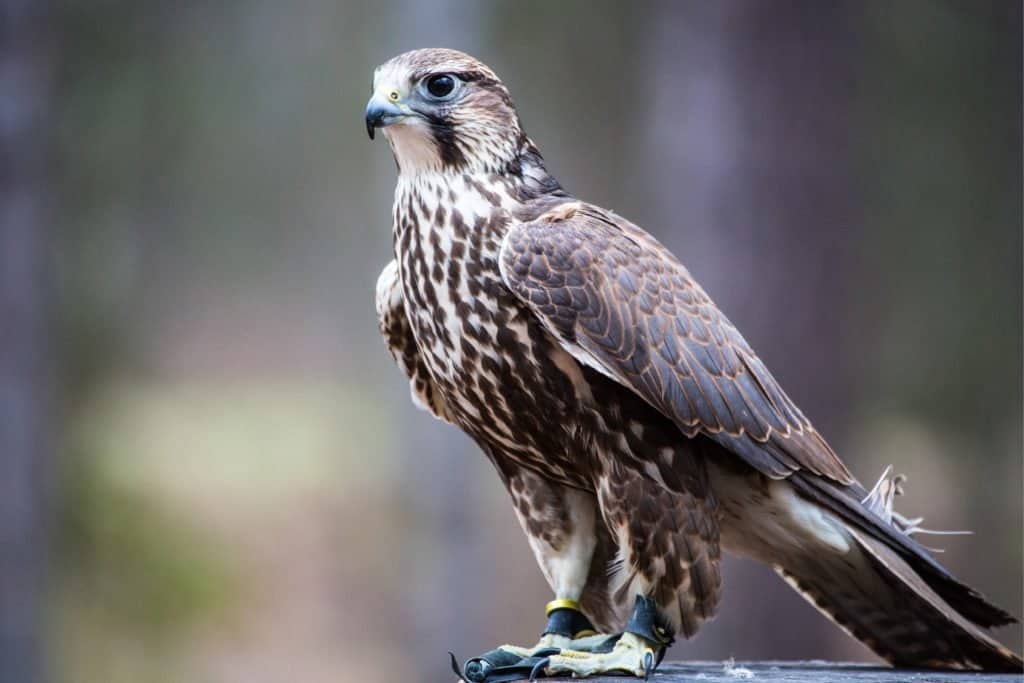
Saker falcon can dive to catch prey at 200 mph.
©Gary C. Tognoni/Shutterstock.com
When flying normally, the bird achieves a speed of 93 mph. The saker falcon has a wingspan of 4 feet, which aids the bird’s flight.
This bird is of major cultural significance, standing as the national bird of Mongolia and Hungary.
These birds reuse nests left by other birds, where they lay three to six eggs. Sadly, the saker falcon remains one of the most endangered bird species.
21. Spur-Winged Goose
This bird is known by the scientific name Plectropterus gambensis. This is a large bird that is related to shelducks and geese. It is mainly found in the wetlands of sub-Saharan Africa. The bird has a maximum airspeed of 89 mph.
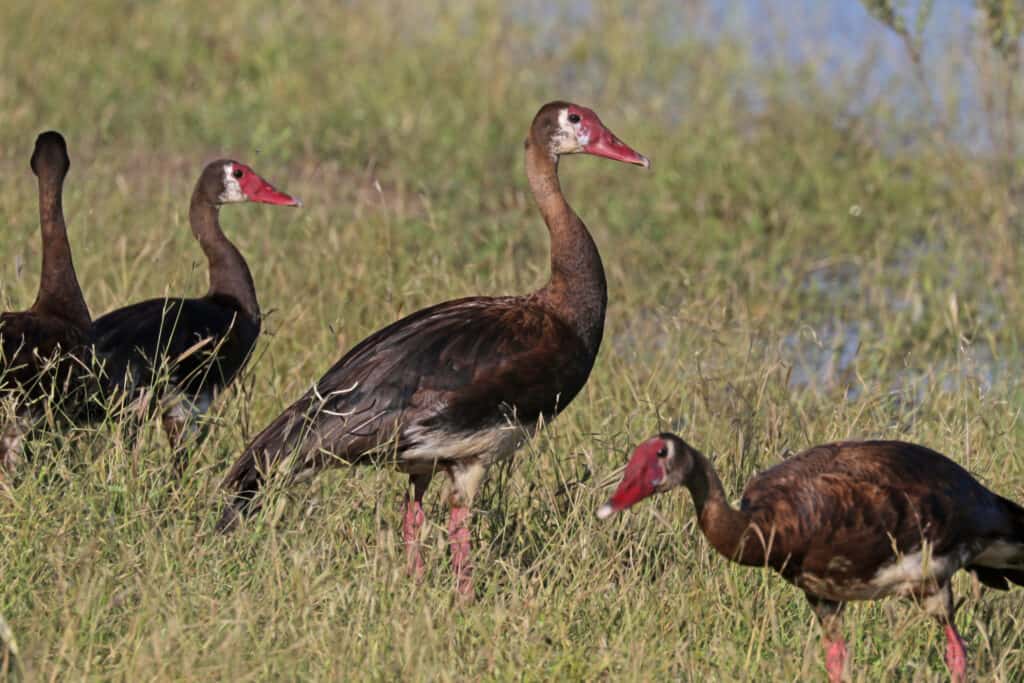
This impressive bird can reach a top speed of 88 miles per hour!
© Charles J. Sharp / CC BY-SA 4.0 – License
Summary of Birds that Start with S
| Common Bird Name | Scientific Name |
|---|---|
| Sage grouse | Centrocercus urophasianus |
| Sage thrasher | Oreoscoptes montanus |
| Sage sparrow | Artemisiospiza nevadensis |
| Scarlet tanager | Piranga olivacea |
| Sandhill crane | Antigone Canadensis |
| Scissor-tailed flycatcher | Tyrannus forficatus |
| Sharp-shinned hawk | Accipiter striatus |
| Short-eared owls | Asio flammeus |
| Skylark | Alauda arvensis |
| Snowy egret | Egretta thula |
| Snowy owl | Bubo scandiacus |
| Smoky brown woodpecker | Leuconotopicus fumigates. |
| Swallow-tailed kite | Elanoides forficatus |
| Surfbird | Calidris virgata |
| Stellar’s jay | Cyanocitta stelleri |
The photo featured at the top of this post is © iStock.com/Elizabeth Lara
Thank you for reading! Have some feedback for us? Contact the AZ Animals editorial team.




